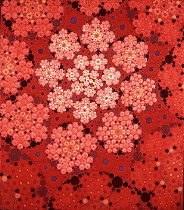
My piece today in the Weekly focuses on Mark Campbell‘s art. Read here. Campbell is one of the artists in “Building References” at Rosenwald-Wolf Gallery which I told you a little about here. It’s a great exhibit and worth chasing down in these last few days (it’s up to April 3, Saturday.)
Here I’d like to say a little more about Bruce Pollock‘s small wood houses in “Building References.” The three tabletop works, which are surprising because they are so different than what I have seen previously by Pollock and thought of as “Pollock” work, are painted with many layers of enamel then scraped and sanded down to reveal underlayers of a hallucinatory nature. Not everybody sees ghosts, of course, but I found the works’ “imagery” a nice comment on the layers of meaning and the layers of perception available to us all if we look and dig enough. The works date from the early 1980s and here’s a quick story about how the artist jumped from working with enamel in a process that involved addition and subtraction, to his current m-o which applies addition, addition, and more addition, without the scrape down and subtraction. (image is one of Pollock’s “Blocks” in “Building References”)
At the opening of “A Closer Look” at Arcadia, an exhibit Pollock also is in right now, I ran into the artist’s gallerist, John Olman of Fleisher-Ollman Gallery, who gave me some background about the little houses and about Pollock’s later work.

Pollock’s materials in the early 1980s (enamels) and his sanding of them is not a particularly healthy studio practice and Ollman said the artist got sick as a result. And in the aftermath, while searching for a similar cosmic vision by means other than layering and sanding enamel, the artist developed a new m-o, one that built up without sanding down and one that used repeated lines and shapes to drive the image. The result, which evokes chemical bonding and biology or stars and snowflakes is work I’m familiar with and have grown to think of as “Pollock.” Here’s Libby’s post on a group show at F-O Gallery that included Pollock. (image is “Red Dextral,” 2003)
The entwining of an artist’s life with the art they make is one of art’s many hidden layers. I’m no formalist and I find that when more is revealed, more is understood, and more is appreciated.









